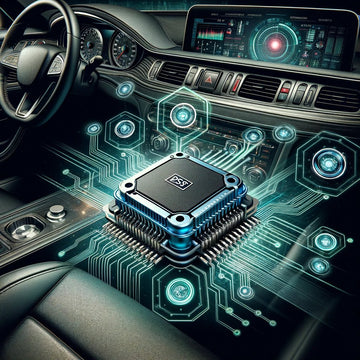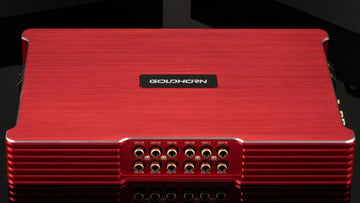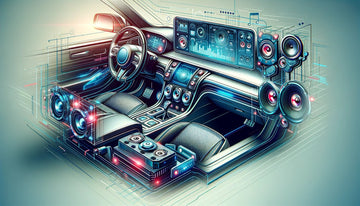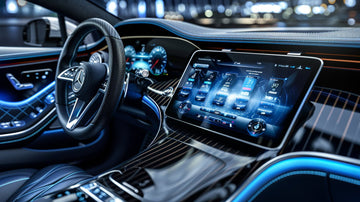Car audio enthusiasts are always looking for ways to improve their sound system, and one of the most effective techniques is digital signal processing (DSP) tuning. DSP tuning allows you to optimize your car audio system's frequency response, clarity, and soundstage, resulting in a truly immersive audio experience. This blog will explore the essentials of DSP tuning for car audio, including its importance, the tools required, and best practices for achieving optimal sound quality. So, let's dive in and master the art of DSP tuning for perfect car audio!
DSP Tuning Essentials for Car Audio
To understand DSP tuning, it is essential to grasp the concept of digital signal processing in-car audio systems. DSP power enables digital signal processing capabilities, allowing for valuable insights into the audio signal tuning process. With DSP tuning, you can optimize your car audio system's frequency response, clarity, and soundstage, making it sound as close to the original recording as possible.
Understanding DSP in Car Audio Systems
DSP tuning entails precise adjustments to different audio parameters, such as equalization, time alignment, and crossover settings, to achieve optimal sound quality. Parametric EQ, a standard tool in DSP tuning, allows you to adjust specific frequency bands, making it easier to correct any frequency response issues and achieve a more balanced sound. Time alignment, another crucial aspect of DSP tuning, ensures that sound from different speakers reaches your ears simultaneously, creating a cohesive listening experience.
When tuning your car audio system using DSP, it's essential to understand the original recording characteristics to preserve the purity of sound. By analyzing the recording characteristics, you can make accurate adjustments to frequency response, equalization, and time alignment, resulting in a more accurate reproduction of the original recording.
Importance of DSP Tuning
DSP tuning is vital in achieving optimal sound quality in-car audio systems. You can achieve clarity, functionality, and purity in audio signal processing by precisely adjusting parameters such as equalization, time alignment, and crossover settings. Let's explore some of the critical reasons why DSP tuning is essential:
- Avoiding common missteps: DSP tuning allows you to avoid common missteps that negatively impact sound quality. You can achieve optimal sound quality by addressing frequency response issues, subwoofer tuning techniques, and amplifier clipping.
- Ensuring accurate soundstage and clarity: DSP tuning allows you to fine-tune the soundstage, ensuring accurate placement of sound sources and creating a more immersive audio experience. It also helps achieve clarity by addressing tweeter resonance and bass distortion.
- Accounting for acoustic properties: Each car has unique acoustic properties that can impact sound quality. DSP tuning allows you to compensate for these properties, ensuring that your audio system sounds its best regardless of the car you drive.
- Preserving purity of sound: DSP tuning helps preserve the purity of sound, making it sound as close to the original recording as possible. By making accurate adjustments to parametric EQ, time alignment, and other parameters, you can ensure that your car audio system reproduces audio with clarity and precision.
Tools Required for Effective DSP Tuning
You'll need a few essential tools when Mastering DSP for Car Audio. These tools are crucial in accurate measurements, analyzing frequency response, and making precise adjustments. Let's explore two essential tools for practical DSP tuning:
The Role of Good Quality Microphone and Calibration for your RTA
A good quality microphone is crucial for accurate measurements during the tuning process. It allows you to capture the frequency response of your car audio system and make necessary adjustments for optimal sound quality. When choosing a microphone, opting for a quality microphone suitable for car audio tuning is essential. Additionally, microphone calibration is necessary to ensure accurate frequency response measurements, making it an essential part of the tuning process.
Sound Deadener's Impact on DSP Tuning
Another factor to consider when tuning your car audio system is the impact of sound-deadening materials. Sound deadeners, such as acoustic foam, soundproofing mats, and vibration dampers, can significantly affect your car audio system's sound quality and frequency response. Proper placement and calibration of sound deadeners can help achieve optimal sound quality, reduce resonance, and improve bass response, making them an essential consideration during tuning.
Step-by-Step Guide to Mastering DSP for Car Audio
Now that we understand the importance of DSP tuning and the tools required let's dive into a step-by-step guide to the tuning process. These steps will help you achieve optimal sound quality in your car audio system.
Tips for Achieving Optimal Sound Quality
To achieve optimal sound quality, here are some valuable tips to keep in mind during the tuning process:
- Pay attention to subwoofer tuning techniques: Subwoofer tuning techniques, such as adjusting subwoofer crossover frequency, subwoofer level, and phase alignment, are crucial in achieving optimal bass response. Make sure to fine-tune these parameters to achieve clarity and accurate bass reproduction.
- Utilize proper equalization techniques: Equalization is a powerful tool in DSP tuning, allowing you to adjust frequency response and balance different frequency bands. Proper equalization techniques, such as parametric EQ, can help achieve a more balanced sound and address frequency response issues.
- Address common missteps: Avoid common missteps that can negatively impact sound quality, such as improper equalization, misalignment of speakers, or clipping in amplifiers. By addressing these issues, you can achieve optimal sound quality and clarity.
- Ensure accurate measurements: Accurate measurements are crucial for making precise adjustments during the tuning process. Use quality measurement tools, such as a calibrated microphone, to capture frequency response accurately and make informed tuning decisions.
- Fine-tune bass tuning techniques: Bass tuning techniques, such as subwoofer placement, subwoofer enclosure design, and bass equalization, have a significant impact on soundstage and clarity. Fine-tuning these parameters can help achieve accurate bass reproduction and a more immersive audio experience.
Avoiding Common DSP Tuning Mistakes and Avoid Clipping
To ensure optimal sound quality, avoiding common missteps that can negatively impact the tuning process is essential. Here are some common DSP tuning mistakes to avoid:
- Neglecting frequency response issues: Frequency response issues, such as peaks and dips, can affect sound quality and clarity. Make sure to address frequency response issues by making accurate parametric EQ adjustments.
- Overlooking tuning nuances: DSP tuning involves nuances that can impact sound quality, such as resonance, time alignment, and equalization techniques. Pay attention to these nuances to achieve optimal sound quality and clarity.
- Ignoring subwoofer tuning techniques: Subwoofer tuning techniques, such as phase alignment, subwoofer crossover frequency, and subwoofer level, are crucial in achieving accurate bass response. Neglecting these techniques can result in bass distortion and suboptimal sound quality.
- Not utilizing accurate measurements: Accurate measurements are essential for making informed tuning decisions. Neglecting accurate measurements using quality tools can lead to suboptimal sound quality and misalignment of speakers.
- Failing to address common missteps: Common missteps, such as clipping in amplifiers, misalignment of speakers, or improper equalization techniques, can negatively impact sound quality. Addressing these missteps is essential for achieving optimal sound quality and clarity.
Remote vs Manual DSP Tuning
When it comes to DSP tuning, you can do remote or manual tuning. Let's explore the unique characteristics and nuances of each tuning method:
Factors Influencing Mastering DSP for Car Audio
Several factors can influence the DSP tuning process, including car type, speaker type, amplifier characteristics, and original recording quality. Let's explore two key factors that can impact your DSP tuning experience.
Does Car Type Affect DSP Tuning?
Yes, car type can significantly affect the DSP tuning process. Each car audio system has unique acoustic properties, making it necessary to adjust digital signal processing tuning parameters accordingly. The tuning process for DSP depends on the nuances and characteristics of different car types, making it essential to tailor the tuning techniques to achieve optimal sound quality in different car models.
Speaker Types (Sub or Subwoofers) and their Impact on DSP Tuning
Different speaker types have unique characteristics that can impact the soundstage, frequency response, and overall audio experience. When tuning your car audio system, it's essential to consider the selection of tweeter types, crossovers, and equalization techniques tailored to different speakers. Additionally, tuning parameters for subwoofer tuning should be adjusted based on different speaker characteristics, ensuring accurate bass response and optimal sound quality.
Best Practices in DSP Tuning?
To achieve the best sound quality in your car audio system, it's essential to follow these best practices in DSP tuning:
- Utilize precision tuning techniques: Precision tuning techniques, such as accurate frequency response measurements, equalization adjustments, and time alignment, are essential for achieving optimal sound quality. Pay attention to these techniques to ensure clarity, functionality, and purity in audio signal processing.
- Understand frequency response nuances: Understanding frequency response nuances is crucial for accurate equalization adjustments. You can achieve a more balanced sound and accurate audio reproduction by addressing frequency response issues like peaks and dips.
- Make effective tuning parameters: Effective tuning parameters, such as equalization, time alignment, and subwoofer tuning, play a crucial role in achieving optimal sound quality. Fine-tune these parameters to achieve clarity, functionality, and accurate soundstage reproduction.
- Achieve accurate measurements: Accurate measurements are essential for making informed tuning decisions. Utilize quality measurement tools, such as calibrated microphones, to capture accurate frequency response and make precise tuning adjustments.
- Address resonance and bass issues: Resonance and bass issues can negatively impact sound quality and clarity. Address resonance issues by making accurate equalization adjustments and fine-tuning bass response through subwoofer tuning techniques, such as placement, equalization, and enclosure design.
Can any car audio system be upgraded with DSP Amplifier?
Any car audio system can be upgraded with DSP, regardless of the make or model. DSP processors can be installed in existing systems to improve sound quality, adjust audio settings, and optimize the performance of speakers and amplifiers. It is a versatile technology that can enhance any car audio setup.
Conclusion
Mastering DSP for Car Audio is crucial for achieving the perfect car audio experience. Understanding the essentials of DSP tuning and investing in the right tools, like a good microphone and sound deadener, can elevate your sound quality to new heights. Following a step-by-step guide and avoiding common mistakes will help you achieve optimal sound quality. Factors such as car type and speaker type also play a role in DSP tuning, so it's essential to consider these factors during the process. To learn more about the best practices in DSP tuning, check out our comprehensive guide in our next blog. Happy tuning!





